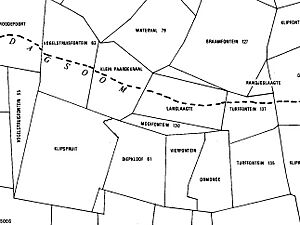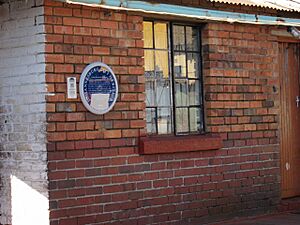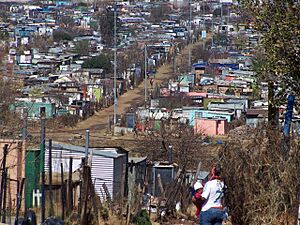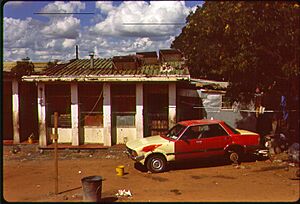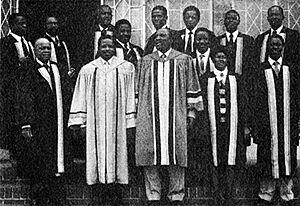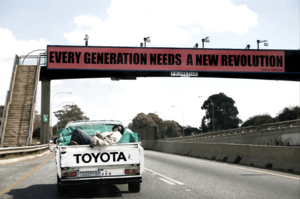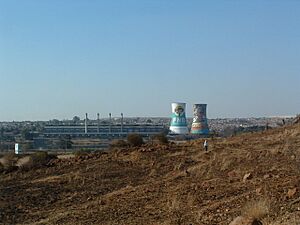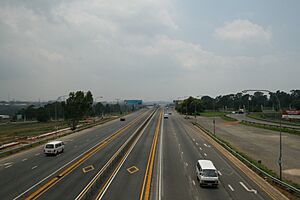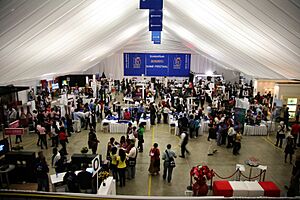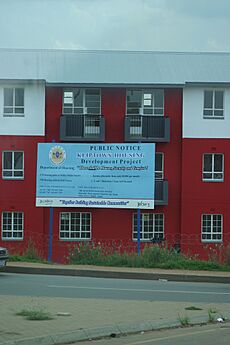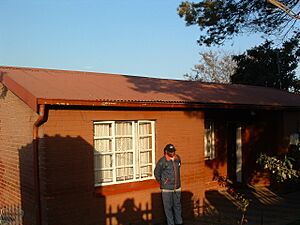Soweto facts for kids
Quick facts for kids
Soweto
South Western Townships
|
|
|---|---|
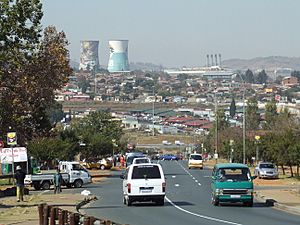
Orlando Towers in the Orlando suburb of Soweto in 2006
|
|
| Country | |
| Province | Gauteng |
| Municipality | City of Johannesburg |
| Area | |
| • Total | 200.03 km2 (77.23 sq mi) |
| Elevation | 1,632 m (5,354 ft) |
| Population
(2011)
|
|
| • Total | 1,271,628 |
| • Density | 6,357.19/km2 (16,465.0/sq mi) |
| Racial makeup (2011) | |
| • Black African | 98.5% |
| • Coloured | 1.0% |
| • Indian/Asian | 0.1% |
| • White | 0.1% |
| • Other | 0.2% |
| First languages (2011) | |
| • Zulu | 37.1% |
| • Sotho | 15.5% |
| • Tswana | 12.9% |
| • Xhosa | 8.9% |
| • Other | 25.6% |
| Time zone | UTC+2 (SAST) |
| Postal code (street) |
1808
|
| Area code | 011 |
Soweto is a large township in Gauteng, South Africa. It is part of the City of Johannesburg Metropolitan Municipality. The name Soweto comes from South Western Townships. It borders Johannesburg's mining area to the south.
Contents
- History of Soweto
- People and Languages in Soweto
- Soweto's Landscape and Landmarks
- Weather in Soweto
- Getting Around Soweto
- Homes in Soweto
- Culture and Entertainment
- Soweto's Suburbs
- Soweto's Economy
- Famous People from Soweto
- See also
History of Soweto
Early Settlements and Gold Discovery
In 1886, gold was found on a farm called Langlaagte. This discovery led to many people moving to the area, hoping to find riches. The town of Johannesburg quickly grew.
People from many different backgrounds settled there. The government bought land and allowed people to make bricks. This area became known as Brickfields. Soon, people of all races lived there.
How Soweto Was Formed
Soweto was created in the 1930s. The government at the time wanted to separate Black people from White people. Black communities were moved away from Johannesburg. They were placed in areas called "townships." These townships were kept separate from White suburbs by natural barriers like rivers or railway tracks. This was done using a law called the Urban Areas Act of 1923.
In 1949, a man named William Carr started a competition to name these townships. Many people suggested names. The city council chose the name SOWETO, which stands for South Western Townships. The name became famous worldwide after the 1976 student uprising.
Soweto grew into the largest Black city in South Africa. However, until 1976, its residents were only seen as temporary workers for Johannesburg.
Important Events in Soweto's History
Soweto faced many challenges during the Apartheid era. Apartheid was a system of laws that enforced racial segregation and discrimination.
In 1976, there were big protests in Soweto. Students were angry because the government wanted them to learn in Afrikaans. This was not their native language. Police responded with violence, and many students were killed or hurt. This event is known as the Soweto uprising.
After the uprising, countries around the world placed economic and cultural restrictions on South Africa. This helped bring about changes. In 1994, South Africa held its first elections where people of all races could vote.
In 2010, Soweto hosted the FIFA World Cup Final. This brought global attention to the township.
Kliptown and Pimville's Beginnings
In 1904, there was a health scare in Brickfields. The town council decided to burn down the shacks there. Most Black residents were moved to a farm called Klipspruit, which was later named Pimville. This area was south-west of Johannesburg.
Pimville was next to Kliptown, which was the oldest Black residential area in Johannesburg. It was first set up in 1891. The future Soweto would be built on Klipspruit and another farm called Diepkloof.
Orlando, Moroka, and Jabavu
In 1923, a law called the Natives (Urban Areas) Act was passed. This law required local governments to provide housing for Black people working in urban areas. Because of this law, the Johannesburg council bought land in 1927. The first houses in what became Orlando Location were built there in 1930. The township was named after Edwin Orlando Leake, who was in charge of Native Affairs.
Around 1934, James Sofasonke Mpanza moved to Orlando. He started his own political party, the Sofasonke Party. In 1944, because of a housing shortage, Mpanza encouraged homeless people to build their own shacks on city land. This led to the creation of squatter camps like Central Western Jabavu and Moroka. These camps were very crowded and had few services.
Chris Hani Baragwanath Hospital
In 1941, the British government built a military hospital near Johannesburg. It was named The Imperial Military Hospital, Baragwanath. After World War II, the hospital was bought by the local government. In 1948, the Black section of Johannesburg Hospital moved there. In 1997, it was renamed Chris Hani Baragwanath Academic Hospital. This was in honor of Chris Hani, a famous political leader.
Apartheid Era in Soweto
The National Party came to power in 1948. Their main policy was Apartheid, which means "separateness" in Afrikaans. They wanted to keep different racial groups in South Africa apart.
Life Under Apartheid (1948-1976)
After 1948, some new houses were built in Soweto. In the 1950s, new laws helped build more low-cost houses. Black people were also allowed to be trained in building trades. A special tax was put on employers of African workers to help pay for basic services in townships.
Dube Village was a special housing project. It was for Black people who were more settled and had better jobs. They could lease land and build their own homes.
In June 1955, a very important meeting called the Congress of the People took place in Kliptown. Here, the Freedom Charter was adopted. This document outlined the vision for a democratic South Africa.
The Apartheid government wanted Soweto to be a place just for workers needed in Johannesburg. They wanted to control where Black workers lived.
New townships like Tladi and Chiawelo were built in 1956. These provided homes for many people. Soweto was divided into areas for different language groups, like Zulu, Xhosa, Sotho, and Tswana speakers.
The government also moved Black people from suburbs near White areas. Between 1956 and 1960, thousands of houses were built in Meadowlands and Diepkloof for those who were moved.
In 1963, the name Soweto was officially chosen for all the townships in the area. The government wanted Soweto to house Black people who worked in Johannesburg.
In 1971, a new law gave the central government more control over Soweto. A board was appointed to manage the township.
The Soweto Uprising
Soweto became known worldwide on 16 June 1976. This was when the Soweto uprising began. Large protests started because the government forced schools to teach in Afrikaans. Students marched from Naledi High School to Orlando Stadium. Police opened fire on them. Many people died, including a young boy named Hector Pieterson.
The protests had a huge impact across South Africa and the world. Other countries put pressure on South Africa through economic and cultural restrictions. Many political activists left the country to fight against Apartheid. Soweto and other townships became places of strong resistance. Since 1991, June 16th is remembered as the International Day of the African Child.
After the Uprising
After the uprising, the government started providing electricity to more homes in Soweto. However, they stopped helping to build new houses. In 1983, Soweto became an independent municipality with elected Black councilors.
These Black councilors did not receive enough money to fix housing and infrastructure problems. Many residents saw them as working for the unfair government. People resisted these new councils. They boycotted local elections for many years.
Soweto Joins the City
During the 1980s, people in Soweto continued to resist Apartheid in many ways. They boycotted schools and businesses. Student groups and community organizations were formed. Churches, like Regina Mundi, were used for political meetings.
In 1995, Soweto became part of the Southern Metropolitan Transitional Local Council. In 2002, it officially joined the City of Johannesburg.
People and Languages in Soweto
Most people in Soweto are Black. The most common first language spoken is Zulu.
Population Facts (2011)
- Area: 200.03 square kilometers
- Population: 1,271,628 people
- Households: 355,331 homes
| Gender | Population | % |
|---|---|---|
| Female | 640,588 | 50.38 |
| Male | 631,040 | 49.62 |
| Race | Population | % |
|---|---|---|
| Black | 1,253,037 | 98.54 |
| White | 1,421 | 0.11 |
| Coloured | 13,079 | 1.03 |
| Asian | 1,418 | 0.11 |
| Other | 2,674 | 0.21 |
| First language | Population | % |
|---|---|---|
| isiZulu | 350,940 | 40.87 |
| isiXhosa | 88,474 | 10.3 |
| Afrikaans | 5,639 | 0.66 |
| Sesotho sa Leboa | 41,179 | 4.8 |
| Setswana | 106,419 | 12.39 |
| English | 3,047 | 0.35 |
| Sesotho | 157,263 | 18.32 |
| Xitsonga | 62,157 | 7.24 |
| siSwati | 8,696 | 1.01 |
| Tshivenda | 29,498 | 3.44 |
| isiNdebele | 2,801 | 0.33 |
| Other | 2,531 | 0.29 |
Soweto's Landscape and Landmarks
Soweto has many important places to visit:
- Chris Hani Baragwanath Academic Hospital, a very large hospital.
- Mandela House, where Nelson Mandela lived.
- Orlando Towers, colorful cooling towers used for bungee jumping.
- Regina Mundi, a church that was important during the Apartheid struggle.
- Vilakazi Street, the only street in the world where two Nobel Prize winners (Nelson Mandela and Desmond Tutu) once lived.
- Walter Sisulu Square, in Kliptown, where the Freedom Charter was adopted.
Weather in Soweto
Soweto has a subtropical highland climate. This means it has warm summers and cool, dry winters.
| Climate data for Soweto | |||||||||||||
|---|---|---|---|---|---|---|---|---|---|---|---|---|---|
| Month | Jan | Feb | Mar | Apr | May | Jun | Jul | Aug | Sep | Oct | Nov | Dec | Year |
| Mean daily maximum °C (°F) | 26.4 (79.5) |
25.8 (78.4) |
24.7 (76.5) |
22.1 (71.8) |
19.6 (67.3) |
16.9 (62.4) |
17.3 (63.1) |
20.3 (68.5) |
23.4 (74.1) |
25 (77) |
25.3 (77.5) |
26.1 (79.0) |
22.7 (72.9) |
| Daily mean °C (°F) | 20.4 (68.7) |
19.8 (67.6) |
18.5 (65.3) |
15.5 (59.9) |
12.1 (53.8) |
9 (48) |
9.2 (48.6) |
12.1 (53.8) |
15.7 (60.3) |
18 (64) |
19 (66) |
19.9 (67.8) |
15.8 (60.3) |
| Mean daily minimum °C (°F) | 14.4 (57.9) |
13.9 (57.0) |
12.3 (54.1) |
8.9 (48.0) |
4.6 (40.3) |
1.2 (34.2) |
1.2 (34.2) |
4 (39) |
8 (46) |
11 (52) |
12.7 (54.9) |
13.7 (56.7) |
8.8 (47.9) |
| Average precipitation mm (inches) | 136 (5.4) |
101 (4.0) |
84 (3.3) |
63 (2.5) |
20 (0.8) |
8 (0.3) |
7 (0.3) |
7 (0.3) |
24 (0.9) |
73 (2.9) |
112 (4.4) |
115 (4.5) |
750 (29.6) |
| Source: Climate-Data.org, altitude: 1667m | |||||||||||||
Getting Around Soweto
Most people in Soweto travel to other parts of Johannesburg for work.
- Trains: Metrorail runs commuter trains between Soweto and central Johannesburg.
- Roads: Major highways like the N1 and N12 connect Soweto to other cities. The Soweto Highway links Soweto to central Johannesburg.
- Taxis: Minibus taxis are a very popular way to travel.
- Buses: The Rea Vaya bus system provides transport for thousands of commuters daily. PUTCO also offers bus services.
Homes in Soweto
Soweto has many old "matchbox" houses. These are small, four-room homes built by the government. They were meant to be cheap housing for Black workers during Apartheid. However, many people have improved and expanded their homes. The city council has also planted more trees and improved parks.
There are also hostels, which were originally built for male workers. Many of these have been changed into homes for families.
Culture and Entertainment
Media
Soweto has its own media:
- Soweto Online is a website with local information.
- Soweto Internet Radio started in 2008.
- Soweto TV is a community television channel. Its studios are on Vilakazi Street.
- The Sowetan newspaper is widely read.
- Kasibiz Mahala is a free magazine that supports local small businesses.
Museums and Memorials
- Hector Pieterson Museum, in Orlando West, remembers the 1976 uprising.
- Nelson Mandela National Museum, also in Orlando West, is Nelson Mandela's former home.
- Regina Mundi church, in Rockville.
Music Scene
Soweto is known as a birthplace for music styles like Kwaito and Kasi rap. These styles mix elements of house music, American hip-hop, and traditional African music. They became very popular among Black South Africans.
Famous artists from Soweto include:
- The Soweto Gospel Choir, known for their powerful voices.
- Soweto String Quartet.
- Soweto Melodic Voices, a youth choir.
Sports in Soweto
- Football: Soweto is home to two top South African football teams: the Kaizer Chiefs and the Moroka Swallows. The Orlando Pirates also started in Soweto. The rivalry between the Chiefs and the Pirates is known as the Soweto derby, one of Africa's biggest football rivalries.
- Tennis: The Soweto Open tennis tournament is held here every year.
- Marathon: The annual Soweto marathon runs through the township.
- Basketball: The Soweto Panthers represent the township in the Basketball National League.
Festivals
The Soweto Wine Festival started in 2004. It takes place every September at the University of Johannesburg's Soweto Campus. It attracts many wine lovers and features South Africa's best wineries.
Soweto Pride is an annual parade held in Soweto. It celebrates black lesbian, queer, and trans women and non-binary people. It also gives them a chance to speak about issues they face.
Stadiums
- FNB Stadium, South Africa's largest stadium.
- Dobsonville Stadium, home to Moroka Swallows.
- Orlando Stadium, home to Orlando Pirates.
Awards
The Soweto Awards honor people who have strong ties to Soweto. Former president Nelson Mandela received a Life Time Award in 2001.
Soweto's Suburbs
The Greater Soweto area includes many townships. Some counts say Soweto itself has between 29 and 34 townships. The exact number can vary depending on how extensions and zones are counted.
Here are some of Soweto's suburbs, with their founding dates and meanings:
| Name | Established | Origin of name |
|---|---|---|
| Braamfischerville | ||
| Tshiawelo | 1956 | "Place of Rest" (Venda) |
| Diepkloof | 1959 | |
| Dlamini | 1956 | Unknown, Nguni family name. |
| Dobsonville | including Dobsonville Gardens | |
| Doornkop | "Hill of Thorns" (Afrikaans) | |
| Dube | 1948 | Named for John Langalibalele Dube, an educator and first ANC president. |
| Emdeni | 1958 | "A border" (Xhosa), including extensions. |
| Greenvillage | ||
| Jabavu | 1948 | Named after Davidson Don Tengo Jabavu, an educator and author. |
| Jabulani | 1956 | "Rejoice" (Zulu) |
| Klipspruit | 1904 | "Rocky Stream" (Afrikaans), originally a farm. |
| Kliptown | "Rocky Town". | |
| Lakeside | ||
| Mapetla | 1956 | Someone who is angry (Setswana) |
| Meadowlands | Also nicknamed "Ndofaya" | |
| Mmesi Park | Sesotho name for somebody who burns things on fire. | |
| Mofolo | 1954 | Named for Thomas Mofolo, a Sesotho author. |
| Molapo | 1956 | Name of a Basotho tribe, Sesotho name for a small ravine. |
| Moletsane | 1956 | Name of a Bataung chief. |
| Moroka | 1946 | Named for Dr James Sebe Moroka, an ANC president. |
| Naledi | 1956 | "Star" (Sotho/Pedi/Tswana), originally Mkizi. |
| Noordgesig | "North View" (Afrikaans) | |
| Orlando | 1932 | Named for Edwin Orlando Leake, a Johannesburg mayor. |
| Phefeni | ||
| Phiri | 1956 | "Hyena" (Sotho/Tswana) |
| Pimville | 1934 | Named for James Howard Pim, a philanthropist; originally part of Klipspruit. |
| Power Park | Near the power station. | |
| Protea Glen | The protea is South Africa's national flower. | |
| Protea North | ||
| Protea South | ||
| Senaoane | 1958 | Named for Solomon G Senaoane, a sports organiser. |
| Tladi | 1956 | "Lightning" (Northern Sotho) |
| Zola | 1956 | "Calm" (Zulu/Xhosa) |
| Zondi | 1956 | Unknown family name (Zulu) |
Other Soweto townships include Phomolong and Snake Park.
Soweto's Economy
Many parts of Soweto are among the poorer areas of Johannesburg. However, some areas have wealthier residents. Generally, areas to the northwest and southeast have lower incomes, while southwestern areas have higher incomes.
The Apartheid government limited Soweto's economic growth. They provided very little infrastructure. Residents were also prevented from starting their own businesses. Soweto was meant to be a place where Black Africans lived only to work in White areas. Laws restricted the types of businesses Sowetans could have. This led to many informal businesses.
By 1976, Soweto had few services. Most houses had no running water. Cooking with fire caused health problems.
In 1977, rules on businesses were lifted. This helped the taxi industry grow. It offered a new way to get around Soweto.
In 1994, Sowetans earned much less than people in wealthier parts of Johannesburg. Some people in Soweto are still poor. Many live in shanty towns with few services. For example, about 85% of Kliptown has informal housing. Some residents struggle to pay for electricity.
However, there are signs of economic improvement. The city council has added more street lights and paved roads. New shopping malls like Protea Mall and Maponya Mall have been built. Soweto is also becoming a lively place for nightlife and culture.
Famous People from Soweto
Born in Soweto
- Yvonne Chaka Chaka (b. 1965), singer and actress.
- Frank Chikane (b. 1951), anti-apartheid activist.
- Bonginkosi Dlamini (b. 1977), musician and actor.
- Lillian Dube (b. 1945), actress.
- Doctor Khumalo (b. 1967), a famous football player.
- Basetsana Kumalo (b. 1974), former Miss South Africa.
- Lebo M (b. 1964), composer, known for The Lion King.
- Thuli Madonsela (b. 1962), former Public Protector of South Africa.
- Teboho MacDonald Mashinini (1957–1990), student leader of the 1976 Soweto uprising.
- Mandla Mandela (b. 1974), grandson of Nelson Mandela.
- Mandoza (1978–2016), kwaito musician.
- Richard Maponya (1920–2020), businessman and activist.
- Trevor Noah (b. 1984), comedian and host of The Daily Show.
- Lucas Radebe (b. 1969), a retired football captain.
- Cyril Ramaphosa (b. 1952), current President of South Africa.
- Tokyo Sexwale (b. 1953), businessman and anti-apartheid activist.
- Jomo Sono (b. 1955), football player and coach.
- Siphiwe Tshabalala (b. 1984), footballer.
- Dingaan Thobela (b. 1966), former boxing world champion, known as the Rose of Soweto.
Other Famous Residents
- James Mpanza (1889–1970), civic leader, known as 'the father of Soweto'.
- Winnie Mandela (1936–2018), anti-apartheid activist and politician.
- Nelson Mandela (1918–2013), former President of South Africa and anti-apartheid leader. His home in Orlando is now a tourist attraction.
- Hector Pieterson (1963–1976), the first student killed during the 1976 Soweto uprising.
- Desmond Tutu (1931–2021), a famous cleric and activist who fought against Apartheid.
See also
 In Spanish: Soweto para niños
In Spanish: Soweto para niños





